Eco-Environmental Risk Assessment and Its Precaution Partitions Based on a Knowledge Graph: A Case Study of Shenzhen City, China
Abstract
:1. Introduction
2. Study Area and Data Source
2.1. Overview of the Study Area
2.2. Data Source and Processing
3. Methods
3.1. Building an Evaluation Framework Based on KGs
3.2. Methodology for ER Assessment
3.3. Spatial Characterization Methods for ER
4. Results
4.1. ER-Based KG Used to Build an Assessment Framework
4.2. Spatial and Temporal Heterogeneity of ERs
4.2.1. Overall Changes
4.2.2. Analysis of Subsystem Changes
4.2.3. Uncertainty Analysis of ER Assessment Results in the Study Area
4.3. Precaution Partitions to Circumvent ER
- (1)
- The key control area of the ER: This area is mainly where the ER shifted from a low to a high grade, and the ER deteriorated. The key control areas are mainly located in the western part of the study area, where ecological land use is scarce and scattered, and construction land use accounts for a large proportion and covers an ever-expanding area, resulting in ecological and environmental pressures; the ER continues to rise. In response to such problems, our future work will focus on improving land use, rationalizing industrial arrangements, and transforming the mode of economic development. Furthermore, establishing a proper ecological compensation system will be essential to promote the natural environment and sustainable socio-economic development [42].
- (2)
- The strict control zone of the ER: This zone is mainly where the grade of ER has not shifted, and the ER has not improved significantly. It should be noted that the strict control zone is targeted at areas with high ER levels (highest- and higher-risk areas). Strict control zones are mainly located in the southwest and southeast of the study area and should play a leading role in territorial spatial planning, where the incremental development of construction land is accompanied by the renewal of stock, to minimize the negative impacts on the ecology and maintain the current level of ecological risk, while promoting economic development [43]. In addition, it is essential to improve the capacity and quality of environmental facilities to make full use of their functions and potential applications, such as the development of ecotourism, the improvement of nature reserves, etc. This management model promotes both the ecological protection of the specific environment and the growth of the regional economy, creating a virtuous circle of benefits.
- (3)
- The general control area of the ER: This area is mainly where the ER shifted from higher to lower grades, with some improvement in the ER. It should be added that the general control area focuses more on the areas where an improvement in rank is not significant. The general control zone is mainly located in the central part of the study area, with a small amount in the southeastern and western parts of the study area. To mitigate some of the negative impacts associated with socio-economic development, targeted ecological protection and restoration should be carried out in this region. In addition, the ecological advantages of the site need to be maintained to prevent further deterioration of the ER, while strengthening the infrastructure [44].
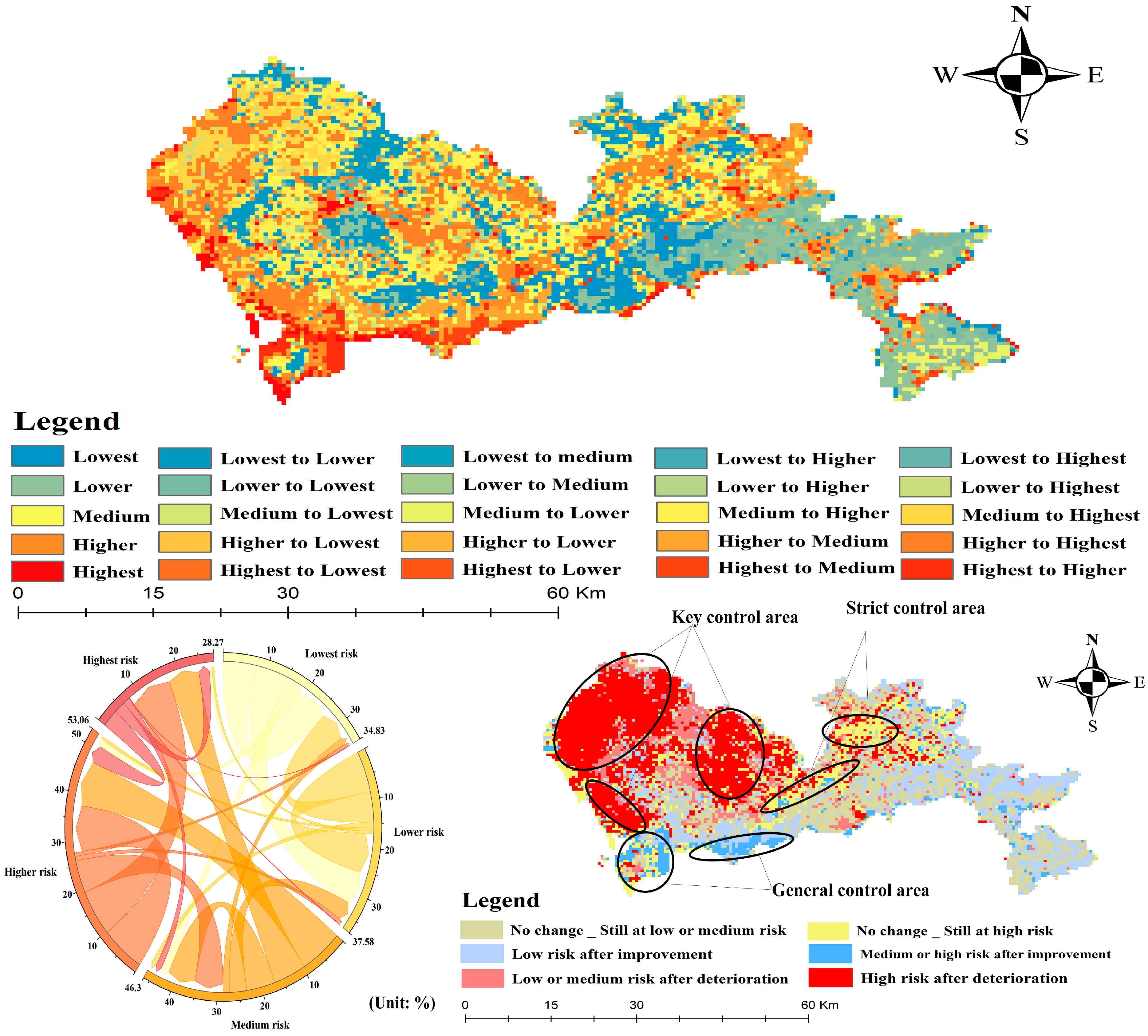
5. Discussion
5.1. Exploration of the ER Assessment Framework
5.2. Exploration of ER Assessment Methods and Results
5.3. Shortcomings and Prospects
6. Conclusions
- (1)
- The average values of ERI from 2000 to 2020 are 0.495 (2000), 0.501 (2010), and 0.538 (2020), and its highest value shows an increasing trend. In terms of spatial distribution, the high-risk area in 2000 was mainly concentrated in the coastal zone of the study area, and the areas distributed in 2010 and 2020 had some similarity, but the distribution results in 2020 were more concentrated. In addition, the mean value of the risk index of the social subsystem was higher than that of the ecological subsystem in the ER’s assessment system.
- (2)
- In order to better elucidate the uncertainty in the ER assessment, three sample sites (A–C) were selected to describe the means and intervals of change of their ERI, risk index of ecological subsystem, and risk index of social subsystem from 2000–2020. To some extent, it shows the uncertainty generated by different weights of indicators and its transmission process.
- (3)
- Based on the quantitative results of ER and its transfer characteristics in the study area from 2000 to 2020, it was divided into key control areas, strict control areas, and general control areas of ER, and targeted improvement measures were proposed. Although the study area is a high-speed urbanization area, particular attention is paid to guaranteeing the coordination of the ecological and social subsystems.
Supplementary Materials
Author Contributions
Funding
Institutional Review Board Statement
Informed Consent Statement
Data Availability Statement
Conflicts of Interest
References
- Li, W.; An, M.; Wu, H.; An, H.; Huang, J.; Khanal, R. The local coupling and telecoupling of urbanization and ecological environment quality based on multisource remote sensing data. J. Environ. Manag. 2023, 327, 116921. [Google Scholar] [CrossRef] [PubMed]
- Zhao, Y.; Li, B.; Ni, J.; Liu, L.; Niu, X.; Liu, J.; Shao, J.; Du, S.; Chu, L.; Jin, J.; et al. Global spatial and temporal patterns of fine particulate concentrations and exposure risk assessment in the context of SDG indicator 11.6.2. Ecol. Indic. 2023, 155, 111031. [Google Scholar] [CrossRef]
- Gao, L.; Tao, F.; Liu, R.; Wang, Z.; Leng, H.; Zhou, T. Multi-scenario simulation and ecological risk analysis of land use based on the PLUS model: A case study of Nanjing. Sustain. Cities Soc. 2022, 85, 104055. [Google Scholar] [CrossRef]
- Wu, J.; Zhu, Q.; Qiao, N.; Wang, Z.; Sha, W.; Luo, K.; Wang, H.; Feng, Z. Ecological risk assessment of coal mine area based on “source-sink” landscape theory—A case study of Pingshuo mining area. J. Clean. Prod. 2021, 295, 126371. [Google Scholar] [CrossRef]
- Cai, X.; Li, Z.; Liang, Y. Tempo-spatial changes of ecological vulnerability in the arid area based on ordered weighted average model. Ecol. Indic. 2021, 133, 108398. [Google Scholar] [CrossRef]
- Qiu, M.; Fu, M.; Zhang, Z.; Fu, S.; Yuan, C. Assessing the ecological risk of croplands in loess drylands by combining environmental disturbance with ecosystem vulnerability. J. Environ. Manag. 2023, 347, 119231. [Google Scholar] [CrossRef]
- Bhuiyan, M.A.H.; Karmaker, S.C.; Doza, B.; Rakib, A.; Saha, B.B. Enrichment, sources and ecological risk mapping of heavy metals in agricultural soils of dhaka district employing SOM, PMF and GIS methods. Chemosphere 2021, 263, 128339. [Google Scholar] [CrossRef]
- Jiao, C.; Chen, L.; Sun, C.; Jiang, Y.; Zhai, L.; Liu, H.; Shen, Z. Evaluating national ecological risk of agricultural pesticides from 2004 to 2017 in China. Environ. Pollut. 2019, 259, 113778. [Google Scholar] [CrossRef]
- Sharma, T.; Vittal, H.; Karmakar, S.; Ghosh, S. Increasing agricultural risk to hydro-climatic extremes in India. Environ. Res. Lett. 2020, 15, 034010. [Google Scholar] [CrossRef]
- Yu, J.; Tang, B.; Chen, Y.; Zhang, L.; Nie, Y.; Deng, W. Landscape ecological risk assessment and ecological security pattern construction in landscape resource-based city: A case study of Zhangjiajie City. Acta Ecol. Sin. 2022, 42, 1290–1299, (In Chinese with English abstract). [Google Scholar]
- Wu, Z.; Lin, C.; Shao, H.; Feng, X.; Chen, X.; Wang, S. Ecological risk assessment and difference analysis of pit ponds under different ecological service functions—A case study of Jianghuai ecological Economic Zone. Ecol. Indic. 2021, 129, 107860. [Google Scholar] [CrossRef]
- Xu, W.; Wang, J.; Zhang, M.; Li, S. Construction of landscape ecological network based on landscape ecological risk assessment in a large-scale opencast coal mine area. J. Clean. Prod. 2021, 286, 125523. [Google Scholar] [CrossRef]
- Lu, Y.; Li, Y.; Fang, G.; Deng, M.; Sun, C. Ecological risk assessment and management for riverfront development along the Yangtze River in Jiangsu Province, China. Ecol. Indic. 2023, 155, 111075. [Google Scholar] [CrossRef]
- Vezi, M.; Downs, C.; Wepener, V.; O’Brien, G. Application of the relative risk model for evaluation of ecological risk in selected river dominated estuaries in KwaZulu-Natal, South Africa. Ocean Coast. Manag. 2019, 185, 105035. [Google Scholar] [CrossRef]
- Ju, H.; Niu, C.; Zhang, S.; Jiang, W.; Zhang, Z.; Zhang, X.; Yang, Z.; Cui, Y. Spatiotemporal patterns and modifiable areal unit problems of the landscape ecological risk in coastal areas: A case study of the Shandong Peninsula, China. J. Clean. Prod. 2021, 310, 127522. [Google Scholar] [CrossRef]
- Proshad, R.; Kormoker, T.; Al, M.A.; Islam, S.; Khadka, S.; Idris, A.M. Receptor model-based source apportionment and ecological risk of metals in sediments of an urban river in Bangladesh. J. Hazard. Mater. 2022, 423, 127030. [Google Scholar] [CrossRef] [PubMed]
- Qian, L.; Shi, Y.; Xu, Q.; Zhou, X.; Li, X.; Shao, X.; Xu, C.; Liang, R. A prospective ecological risk assessment method based on exposure and ecological scenarios (ERA-EES) to determine soil ecological risks around metal mining areas. Sci. Total. Environ. 2023, 901, 166371. [Google Scholar] [CrossRef]
- Liu, C.; Zhang, X.; Xu, Y.; Xiang, B.; Gan, L.; Shu, Y. Knowledge graph for maritime pollution regulations based on deep learning methods. Ocean Coast. Manag. 2023, 242, 106679. [Google Scholar] [CrossRef]
- Li, J.; Sun, A.; Han, J.; Li, C. A Survey on Deep Learning for Named Entity Recognition. IEEE Trans. Knowl. Data Eng. 2022, 34, 50–70. [Google Scholar] [CrossRef]
- Singh, J.; Kumaraswamidhas, L.; Bura, N.; Sharma, N.D. A Monte Carlo simulation investigation on the effect of the probability distribution of input quantities on the effective area of a pressure balance and its uncertainty. Measurement 2021, 172, 108853. [Google Scholar] [CrossRef]
- Roszkowski, M. Modelling doctoral dissertations in Wikidata knowledge graph: Selected issues. J. Acad. Libr. 2022, 49, 102658. [Google Scholar] [CrossRef]
- Saad, M.; Zhang, Y.; Tian, J.; Jia, J. A graph database for life cycle inventory using Neo4j. J. Clean. Prod. 2023, 393, 136344. [Google Scholar] [CrossRef]
- Han, F.; Deng, Y.; Liu, Q.; Zhou, Y.; Wang, J.; Huang, Y.; Zhang, Q.; Bian, J. Construction and application of the knowledge graph method in management of soil pollution in contaminated sites: A case study in South China. J. Environ. Manag. 2022, 319, 115685. [Google Scholar] [CrossRef] [PubMed]
- Wang, X.; Meng, L.; Wang, X.; Wang, Q. The construction of environmental-policy-enterprise knowledge graph based on PTA model and PSA model. Resour. Conserv. Recycl. Adv. 2021, 12, 200057. [Google Scholar] [CrossRef]
- Yang, Y.J.; Song, G.; Lu, S. Assessment of land ecosystem health with Monte Carlo simulation: A case study in Qiqihaer, China. J. Clean. Prod. 2020, 250, 119522. [Google Scholar] [CrossRef]
- Jia, C.; Altaf, A.R.; Li, F.; Ashraf, I.; Zafar, Z.; Nadeem, A.A. Comprehensive assessment on groundwater quality, pollution characteristics, and ecological health risks under seasonal thaws: Spatial insights with Monte Carlo simulations. Groundw. Sustain. Dev. 2023, 22, 100952. [Google Scholar] [CrossRef]
- Barandas, M.; Famiglini, L.; Campagner, A.; Folgado, D.; Simão, R.; Cabitza, F.; Gamboa, H. Evaluation of uncertainty quantification methods in multi-label classification: A case study with automatic diagnosis of electrocardiogram. Inf. Fusion 2023, 101, 101978. [Google Scholar] [CrossRef]
- Zhao, J.; Pan, B. Uncertainty quantification for 3D digital image correlation displacement measurements using Monte Carlo method. Opt. Lasers Eng. 2023, 170, 107777. [Google Scholar] [CrossRef]
- Rullens, V.; Stephenson, F.; Hewitt, J.E.; Clark, D.E.; Pilditch, C.A.; Thrush, S.F.; Ellis, J.I. The impact of cumulative stressor effects on uncertainty and ecological risk. Sci. Total Environ. 2022, 842, 156877. [Google Scholar] [CrossRef]
- Zhou, Y.; Zheng, Z.; Wu, Z.; Guo, C.; Chen, Y. Construction and evaluation of ecological networks in highly urbanised regions: A case study of the Guangdong-Hong Kong-Macao greater Bay Area, China. Ecol. Indic. 2023, 152, 110336. [Google Scholar] [CrossRef]
- Wang, Z.H.; Yang, X.M.; Zhou, C.H. Geographic Knowledge Graph for Remote Sensing Big Data. J. Geo-Inf. Sci. 2021, 23, 16–28. [Google Scholar] [CrossRef]
- Wang, T.Y.; Meng, X.L.; Zhang, H. Knowledge Graph Construction Method in the Ecology and Environment Field. Geospat. Inf. 2023, 21, 14–19, (In Chinese with English abstract). [Google Scholar]
- Deng, L.; Qi, P.H.; Liu, Z.H.; Li, J.; Tang, J. BGPNRE: A BERT-based Global Pointer Network for Named Entity-Relation Joint Extraction Method. Comput. Sci. 2023, 50, 42–48. [Google Scholar] [CrossRef]
- Yao, Y.; Yang, F. Chinese Keyword Extraction Method Combining Knowledge Graph and Pre-training Model. Comput. Sci. 2022, 49, 243–251. [Google Scholar] [CrossRef]
- Abarna, S.; Sheeba, J.; Devaneyan, S.P. An ensemble model for idioms and literal text classification using knowledge-enabled BERT in deep learning. Meas. Sens. 2022, 24, 100434. [Google Scholar] [CrossRef]
- Zhang, Y.; Li, J.; Xin, Y.; Zhao, X.; Liu, Y. A Model for Chinese Named Entity Recognition Based on Global Pointer and Adversarial Learning. Chin. J. Electron. 2023, 32, 854–867. [Google Scholar] [CrossRef]
- Wu, S.S.; Zhou, A.L.; Xie, N.F. Construction of visualization domain-specific knowledge graph of crop diseases and pests based on deep learning. Trans. Chin. Soc. Agric. Eng. 2000, 36, 177–185. [Google Scholar] [CrossRef]
- Singh, K.; Lytra, I.; Radhakrishna, A.S.; Shekarpour, S.; Vidal, M.-E.; Lehmann, J. No one is perfect: Analysing the performance of question answering components over the DBpedia knowledge graph. J. Web Semant. 2020, 65, 100594. [Google Scholar] [CrossRef]
- Zhang, F.; Liu, X.; Zhang, J.; Wu, R.; Ma, Q.; Chen, Y. Ecological vulnerability assessment based on multi-sources data and SD model in Yinma River Basin, China. Ecol. Model. 2017, 349, 41–50. [Google Scholar] [CrossRef]
- Zhang, W.; Liu, G.; Yang, Z. Urban agglomeration ecological risk transfer model based on Bayesian and ecological network. Resour. Conserv. Recycl. 2020, 161, 105006. [Google Scholar] [CrossRef]
- Na, L.; Zhao, Y.; Feng, C.-C.; Guo, L. Regional ecological risk assessment based on multi-scenario simulation of land use changes and ecosystem service values in Inner Mongolia, China. Ecol. Indic. 2023, 155, 111013. [Google Scholar] [CrossRef]
- Cueva, J.; Yakouchenkova, I.A.; Fröhlich, K.; Dermann, A.F.; Dermann, F.; Köhler, M.; Grossmann, J.; Meier, W.; Bauhus, J.; Schröder, D.; et al. Synergies and trade-offs in ecosystem services from urban and peri-urban forests and their implication to sustainable city design and planning. Sustain. Cities Soc. 2022, 82, 103903. [Google Scholar] [CrossRef]
- Liu, Z.; Huang, Q.; Zhou, Y.; Sun, X. Spatial identification of restored priority areas based on ecosystem service bundles and urbanization effects in a megalopolis area. J. Environ. Manag. 2022, 308, 114627. [Google Scholar] [CrossRef] [PubMed]
- Guo, H.; Cai, Y.; Li, B.; Wan, H.; Yang, Z. An improved approach for evaluating landscape ecological risks and exploring its coupling coordination with ecosystem services. J. Environ. Manag. 2023, 348, 119277. [Google Scholar] [CrossRef] [PubMed]
- Zhang, W.; Liu, G.; Ghisellini, P.; Yang, Z. Ecological risk and resilient regulation shifting from city to urban agglomeration: A review. Environ. Impact Assess. Rev. 2024, 105, 107386. [Google Scholar] [CrossRef]
- Xie, X.X.; Chen, M.Q.; Tian, Y. Land Ecological Research Hotspots in Recent 20 Years in China and Its Prospect: A Knowledge Map Analysis based on the Ucinet. China Land Sci. 2018, 32, 88–96, (In Chinese with English abstract). [Google Scholar]
- Ashraf, A.; Khalid, A.; Khan, I.; Yuke, Z.; Zhigang, C.; Zhaoxue, T.; Leite, F.; Xuehua, L. Integrated multiphase ecological risk assessment of heavy metals for migratory water birds in wetland ecosystem: A case study of Dongzhangwu Wetland, China. Sci. Total Environ. 2023, 889, 164102. [Google Scholar] [CrossRef]
- Lu, H.; Fu, Z.; Tong, Y.; Xiang, S.; Sun, Y.; Wu, F. Combined pollution characteristics and ecological risks of multi-pollutants in Poyang Lake. Environ. Pollut. 2024, 342, 123116. [Google Scholar] [CrossRef]
- Lin, X.; Wang, Z. Landscape ecological risk assessment and its driving factors of multi-mountainous city. Ecol. Indic. 2023, 146, 109823. [Google Scholar] [CrossRef]
- Hou, Y.; Liu, Y.; Zeng, H. Assessment of urban ecosystem condition and ecosystem services in Shenzhen based on the MAES analysis framework. Ecol. Indic. 2023, 155, 110962. [Google Scholar] [CrossRef]
- Liu, R.; Zhang, L.; Tang, Y.; Jiang, Y. Understanding and evaluating the resilience of rural human settlements with a social-ecological system framework: The case of Chongqing Municipality, China. Land Use Policy 2024, 136, 106966. [Google Scholar] [CrossRef]
- Qu, Y.; Zong, H.; Su, D.; Ping, Z.; Guan, M. Land Use Change and Its Impact on Landscape Ecological Risk in Typical Areas of the Yellow River Basin in China. Int. J. Environ. Res. Public Health 2021, 18, 11301. [Google Scholar] [CrossRef] [PubMed]
- Zhang, W.; Liu, G.; Gonella, F.; Xu, L.; Yang, Z. Research on collaborative management and optimization of ecological risks in urban agglomeration. J. Clean. Prod. 2022, 372, 133735. [Google Scholar] [CrossRef]
- Zhang, H.; Liu, Y.; Li, X.; Feng, R.; Gong, Y.; Jiang, Y.; Guan, X.; Li, S. Combing remote sensing information entropy and machine learning for ecological environment assessment of Hefei-Nanjing-Hangzhou region, China. J. Environ. Manag. 2023, 325, 116533. [Google Scholar] [CrossRef] [PubMed]
- Li, Y.; Lu, C.; Liu, G.; Chen, Y.; Zhang, Y.; Wu, C.; Liu, B.; Shu, L. Risk assessment of wetland degradation in the Xiong’an New Area based on AHP-EWM-ICT method. Ecol. Indic. 2023, 153, 110443. [Google Scholar] [CrossRef]
- Gong, J.; Jin, T.; Cao, E.; Wang, S.; Yan, L. Is ecological vulnerability assessment based on the VSD model and AHP-Entropy method useful for loessial forest landscape protection and adaptative management? A case study of Ziwuling Mountain Region, China. Ecol. Indic. 2022, 143, 109379. [Google Scholar] [CrossRef]
- Zeng, C.; He, J.; He, Q.; Mao, Y.; Yu, B. Assessment of Land Use Pattern and Landscape Ecological Risk in the Chengdu-Chongqing Economic Circle, Southwestern China. Land 2022, 11, 659. [Google Scholar] [CrossRef]
- Shen, W.; Zhang, J.; Wang, K.; Zhang, Z. Identifying the spatio-temporal dynamics of regional ecological risk based on Google Earth Engine: A case study from Loess Plateau, China. Sci. Total Environ. 2023, 873, 162346. [Google Scholar] [CrossRef]
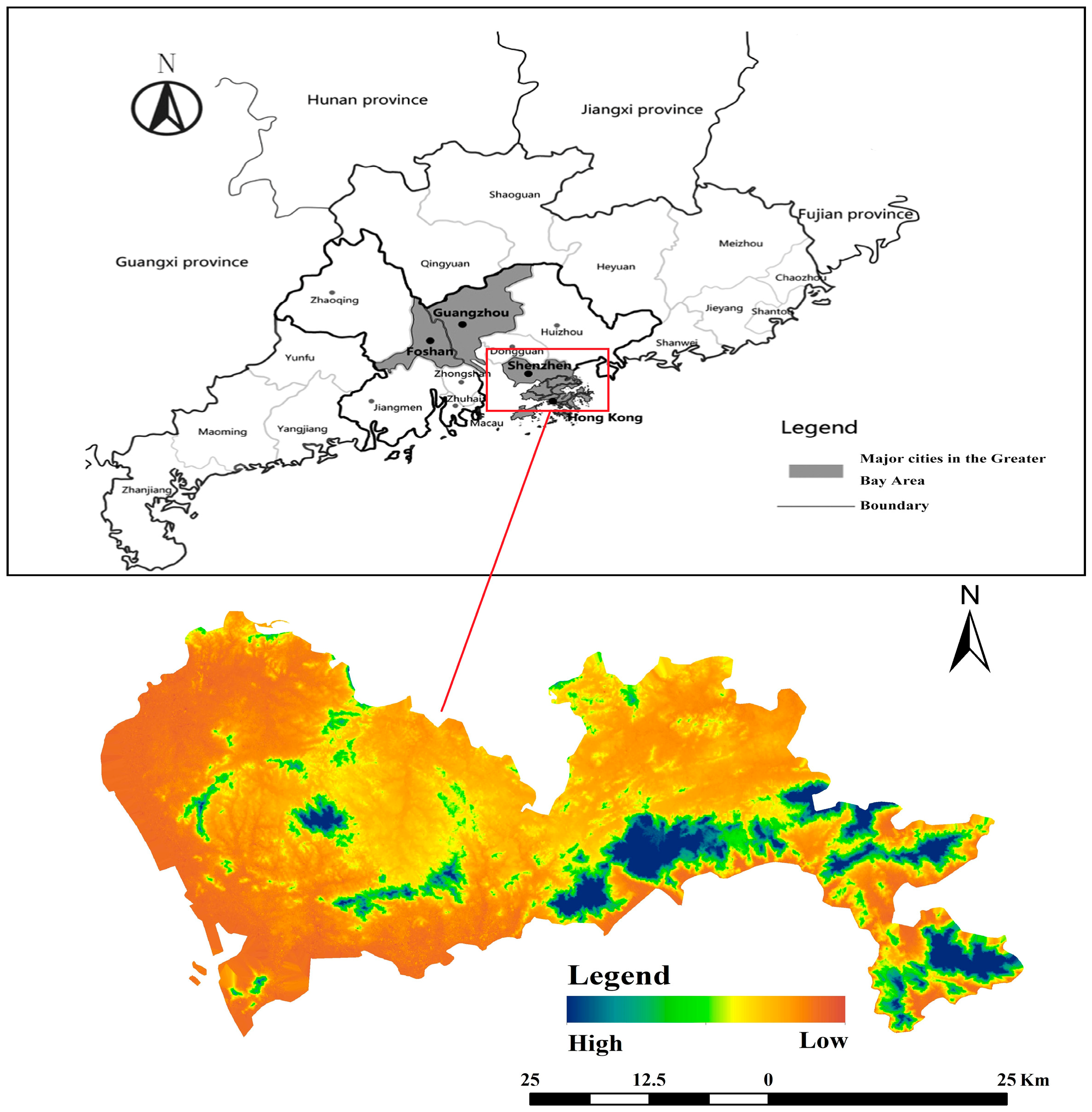
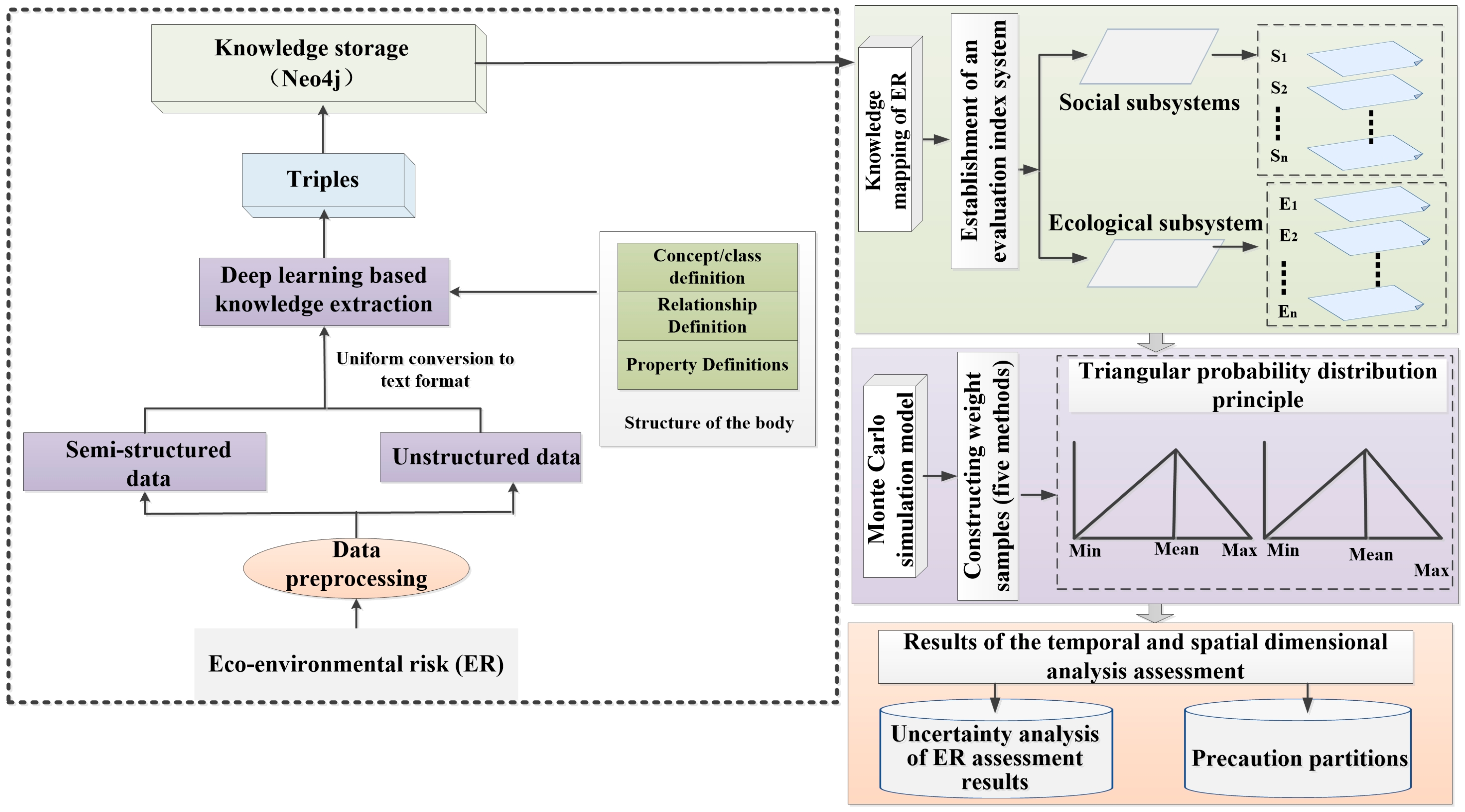
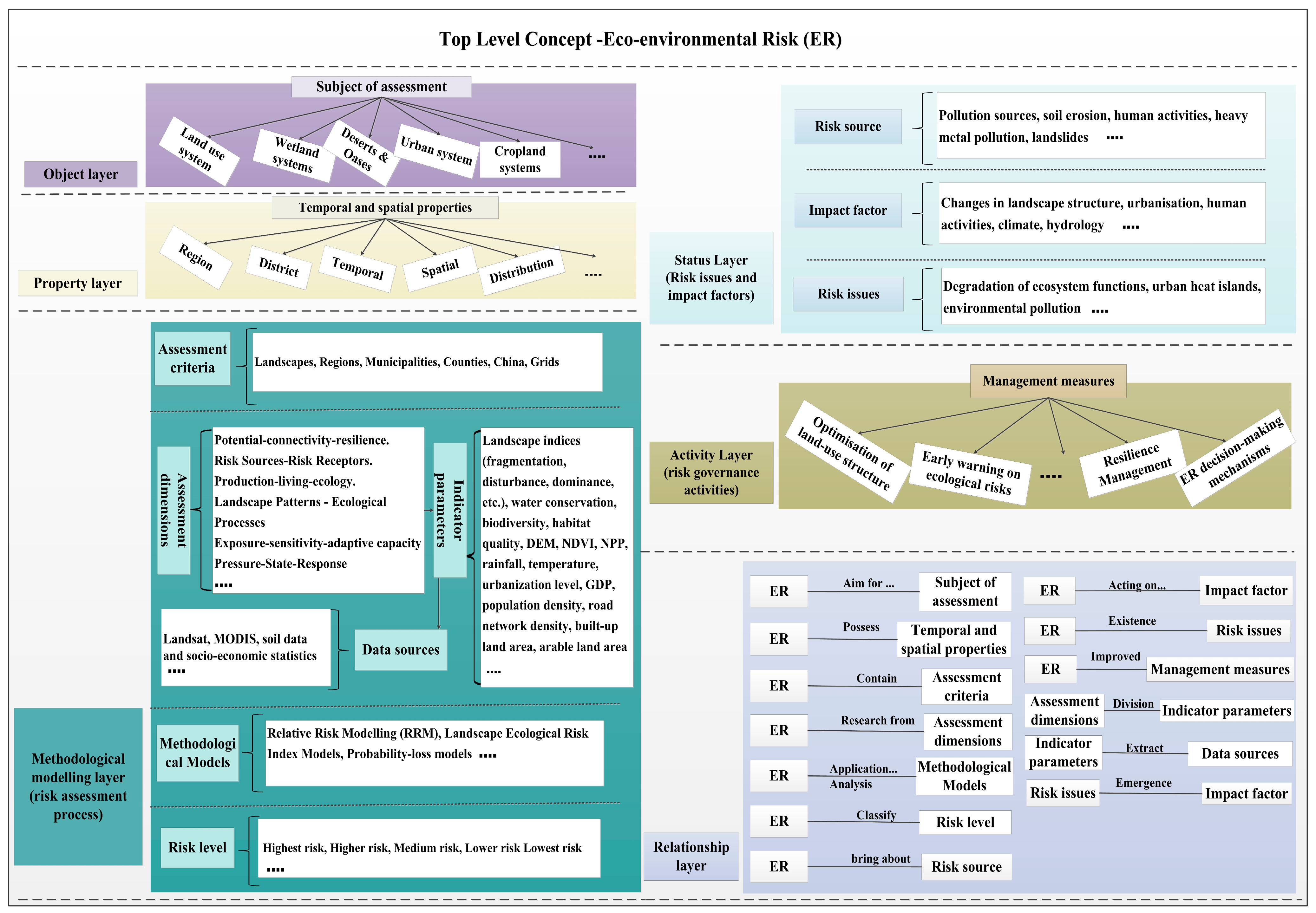
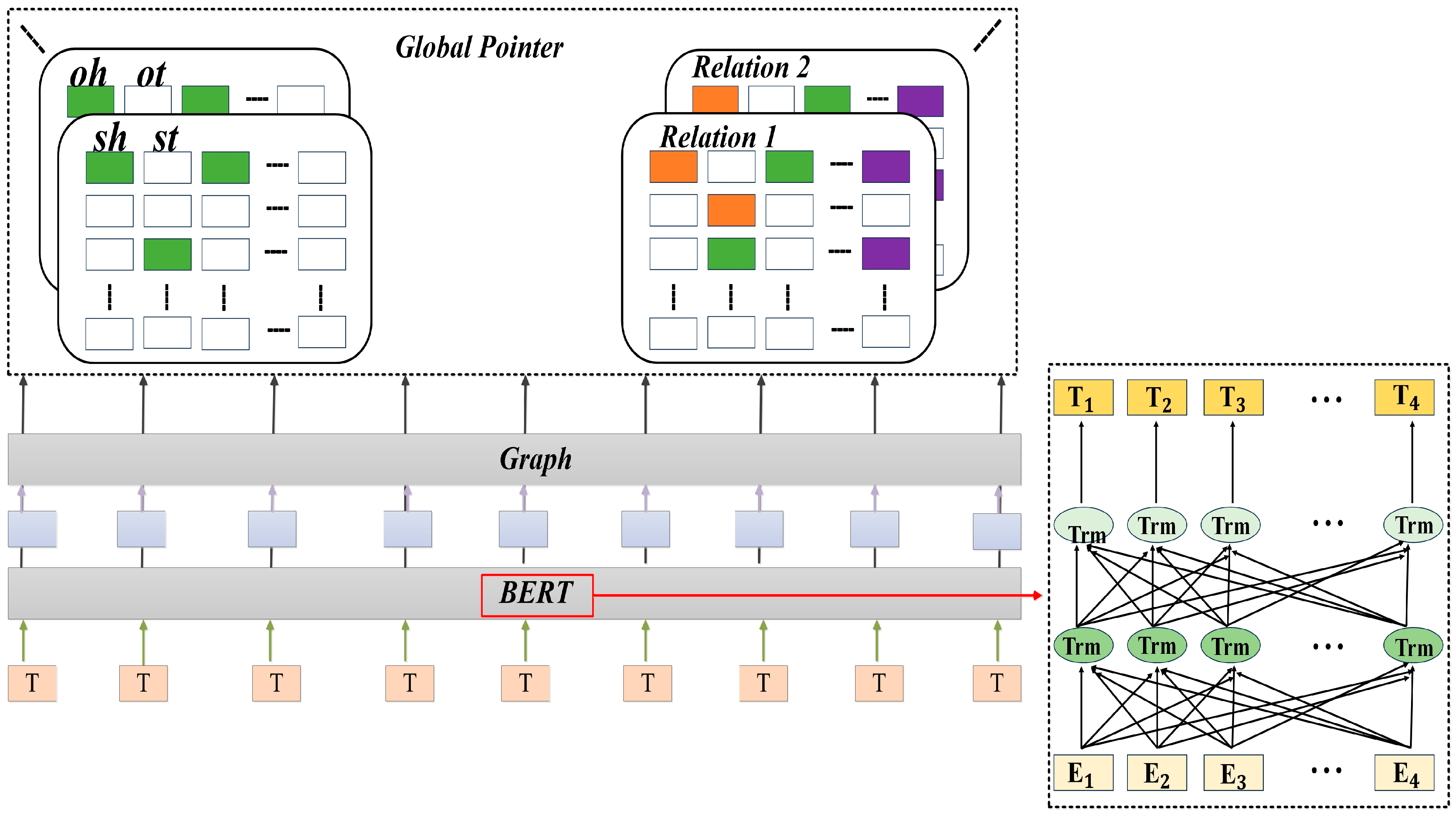


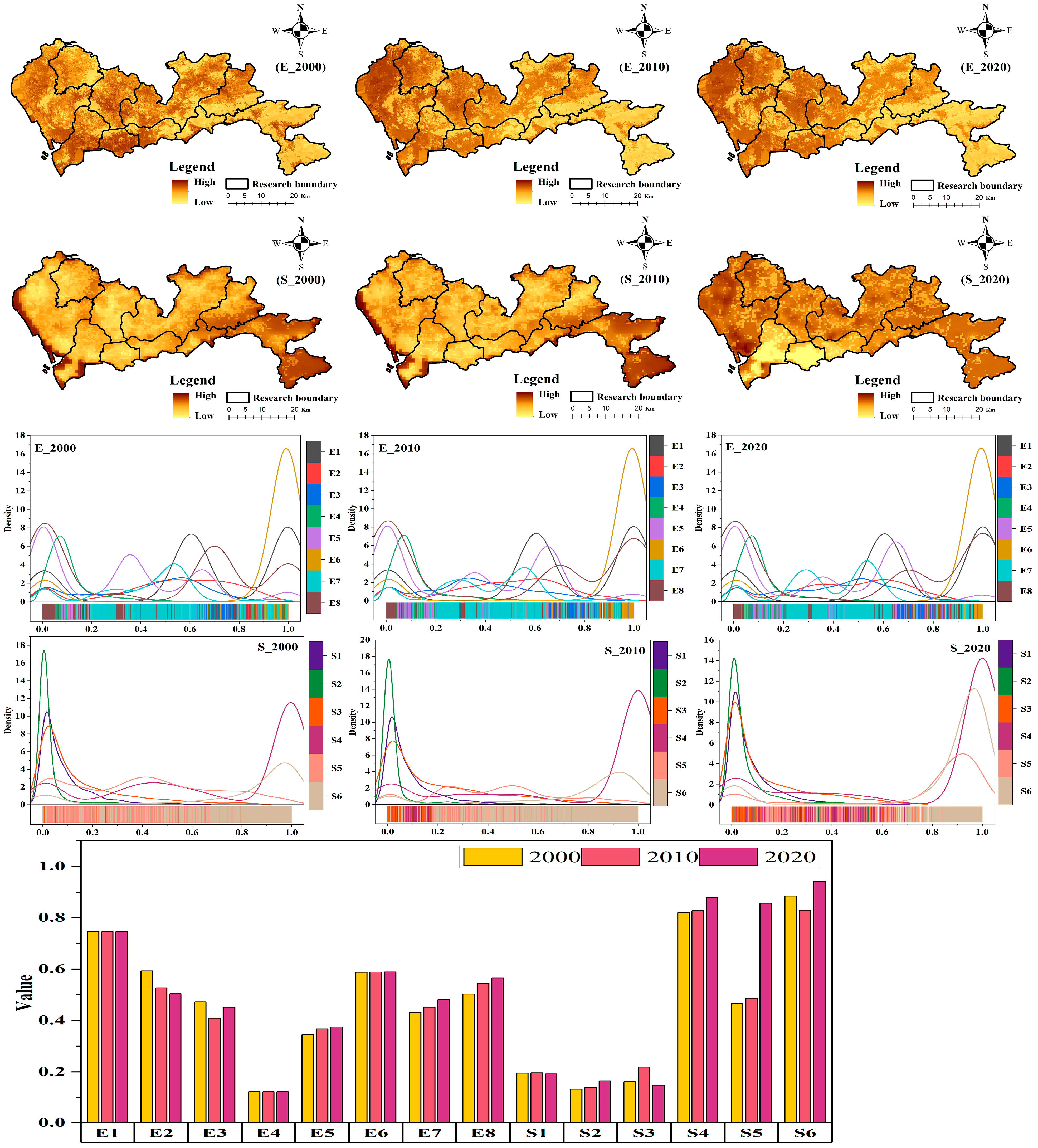
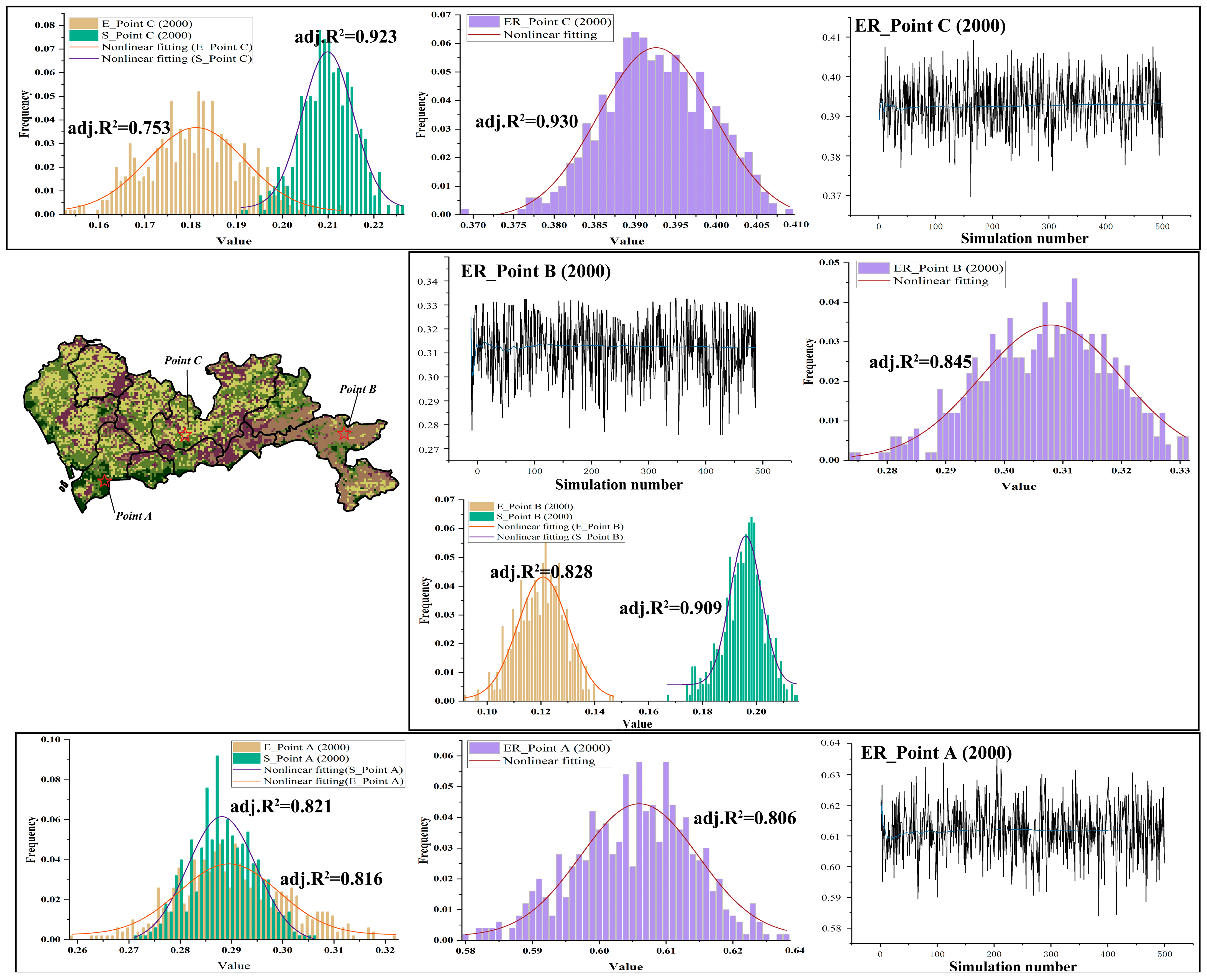
| Category | Data | Data Sources | Website Source |
|---|---|---|---|
| Spatial data | China Basin and River Network Dataset | Resource and Environmental Science Data Center of the Chinese Academy of Sciences | http://www.resdc.cn/ (accessed on 2 June 2023). |
| Vector boundary data | |||
| GDP Spatial Distribution Kilometer Grid Dataset (Resolution: 1 km) | |||
| Population Spatial Distribution Kilometer Grid Dataset (Resolution: 1 km) | |||
| Digital elevation data (Resolution: 30 m) | Geospatial data cloud | http://www.gscloud.cn/ (accessed on 3 May 2023). | |
| Land-use data (Resolution: 30 m) | |||
| Normalized Difference Vegetation Index (NDVI) (Resolution: 30 m) | |||
| Landsat remote sensing images | USGS website | http://glovis.usgs.gov (accessed on 14 March 2023). | |
| Chinese soil data set in the Harmonized World Soil Database (HWSD) | National Tibetan Plateau Data Center | http://data.tpdc.ac.cn (accessed on 1 February 2023). | |
| Point of interest data | Baidu Map Company, Beijing, China | http://map.baidu.com (accessed on 15 February 2023). | |
| Statistical data | Dataset of daily values of surface climate data in China (V3.0) | China Meteorological Data Network | http://data.cma.cn/ (accessed on 9 July 2023). |
| Food production | China Economic and Social Big Data Research Platform | http://www.data.cnki.net (accessed on 14 April 2023). | |
| Shenzhen Water Resources Bulletin | Shenzhen Municipal Government Portal | http://www.sz.gov.cn/ (accessed on 14 April 2023). | |
| Shenzhen Statistical Yearbook | China Yearbook Network | http://www.yearbook.cn/ (accessed on 15 April 2023). |
| Times | ) | ||
|---|---|---|---|
| Epoch = 50 | 0.82 | 0.81 | 0.81 |
| Epoch = 100 | 0.85 | 0.86 | 0.85 |
| Epoch = 200 | 0.86 | 0.86 | 0.87 |
| Object | Subsystems | Indicators | No. | Indicator Character |
|---|---|---|---|---|
| ER | Ecological subsystem | Soil erodibility factors (K) | E1 | + |
| Surface temperature (LST) | E2 | + | ||
| Average annual rainfall | E3 | + | ||
| DEM | E4 | + | ||
| Carbon storage (Calculated by the InVSET model) | E5 | − | ||
| Soil conservation (Calculated by the InVSET model) | E6 | − | ||
| Water conservation (Calculated by the InVSET model) | E7 | − | ||
| Habitat quality (Calculated by the InVSET model) | E8 | − | ||
| Social subsystems | Population density | S1 | + | |
| Disturbance density of transport facilities | S2 | + | ||
| Industrial density | S3 | + | ||
| Food production per unit area | S4 | − | ||
| Economic density | S5 | − | ||
| Density of parkland | S6 | − |
| Indicator | Max | Min | Mean | Indicator | Max | Min | Mean |
|---|---|---|---|---|---|---|---|
| E1 | 0.064 | 0.015 | 0.037 | S1 | 0.101 | 0.009 | 0.052 |
| E2 | 0.102 | 0.023 | 0.062 | S2 | 0.089 | 0.049 | 0.068 |
| E3 | 0.095 | 0.014 | 0.063 | S3 | 0.088 | 0.012 | 0.054 |
| E4 | 0.084 | 0.015 | 0.055 | S4 | 0.115 | 0.018 | 0.071 |
| E5 | 0.106 | 0.019 | 0.064 | S5 | 0.533 | 0.035 | 0.168 |
| E6 | 0.131 | 0.017 | 0.072 | S6 | 0.135 | 0.021 | 0.078 |
| E7 | 0.156 | 0.014 | 0.074 | ||||
| E8 | 0.186 | 0.018 | 0.081 |
| Year | Lowest-Risk Area | Lower-Risk Area | Medium-Risk Area | Higher-Risk Area | Highest-Risk Area |
|---|---|---|---|---|---|
| 2000 | 18.72% | 17.08% | 28.73% | 27.68% | 7.79% |
| 2010 | 20.27% | 17.88% | 21.07% | 26.79% | 13.99% |
| 2020 | 16.11% | 20.46% | 17.57% | 25.39% | 20.47% |
| Value | 2000 | 2010 | 2020 |
|---|---|---|---|
| Moran’ s I | 0.756 | 0.785 | 0.791 |
Disclaimer/Publisher’s Note: The statements, opinions and data contained in all publications are solely those of the individual author(s) and contributor(s) and not of MDPI and/or the editor(s). MDPI and/or the editor(s) disclaim responsibility for any injury to people or property resulting from any ideas, methods, instructions or products referred to in the content. |
© 2024 by the authors. Licensee MDPI, Basel, Switzerland. This article is an open access article distributed under the terms and conditions of the Creative Commons Attribution (CC BY) license (https://creativecommons.org/licenses/by/4.0/).
Share and Cite
Yang, Y.; Zhu, X. Eco-Environmental Risk Assessment and Its Precaution Partitions Based on a Knowledge Graph: A Case Study of Shenzhen City, China. Sustainability 2024, 16, 909. https://doi.org/10.3390/su16020909
Yang Y, Zhu X. Eco-Environmental Risk Assessment and Its Precaution Partitions Based on a Knowledge Graph: A Case Study of Shenzhen City, China. Sustainability. 2024; 16(2):909. https://doi.org/10.3390/su16020909
Chicago/Turabian StyleYang, Yijia, and Xuexin Zhu. 2024. "Eco-Environmental Risk Assessment and Its Precaution Partitions Based on a Knowledge Graph: A Case Study of Shenzhen City, China" Sustainability 16, no. 2: 909. https://doi.org/10.3390/su16020909






